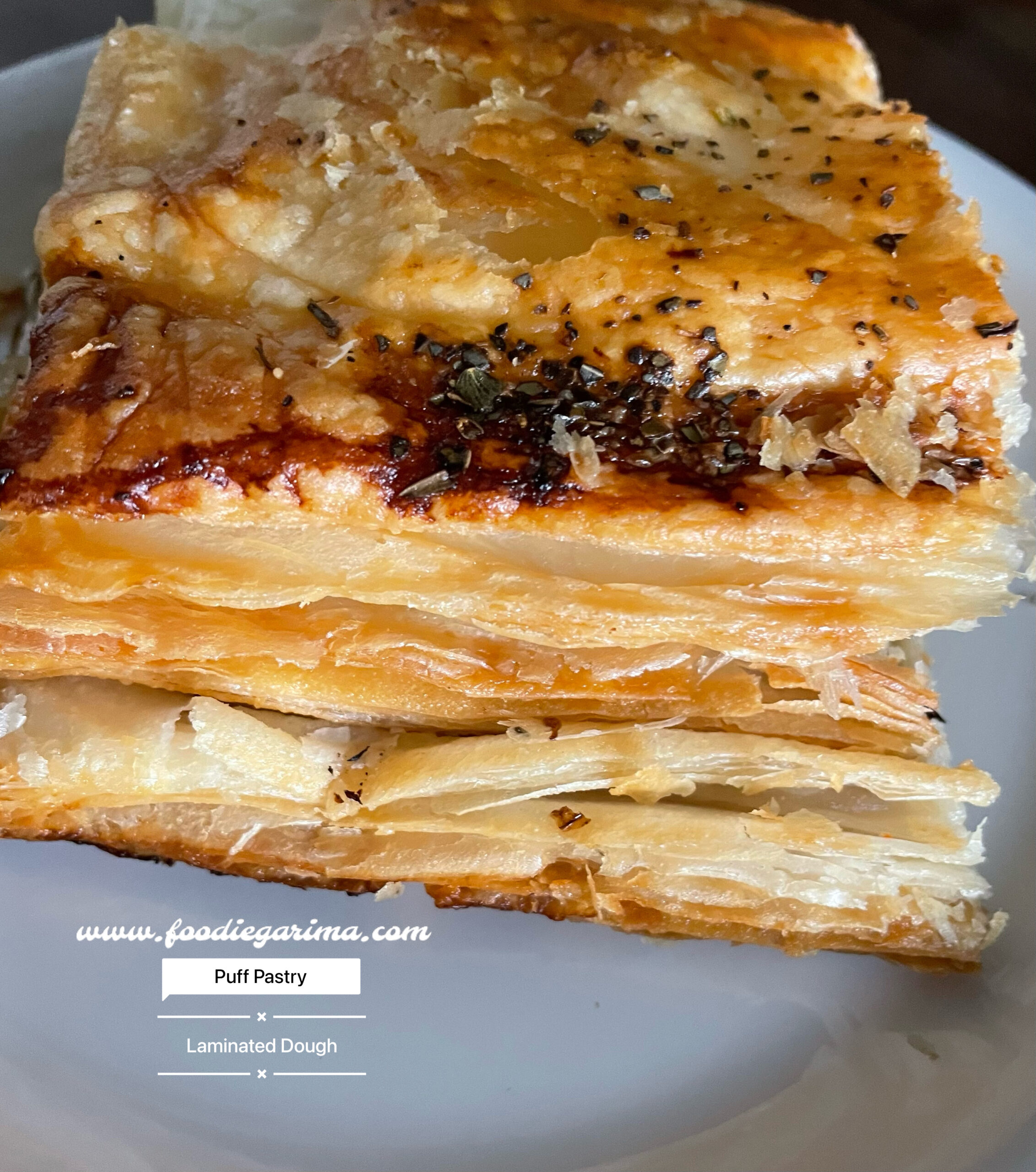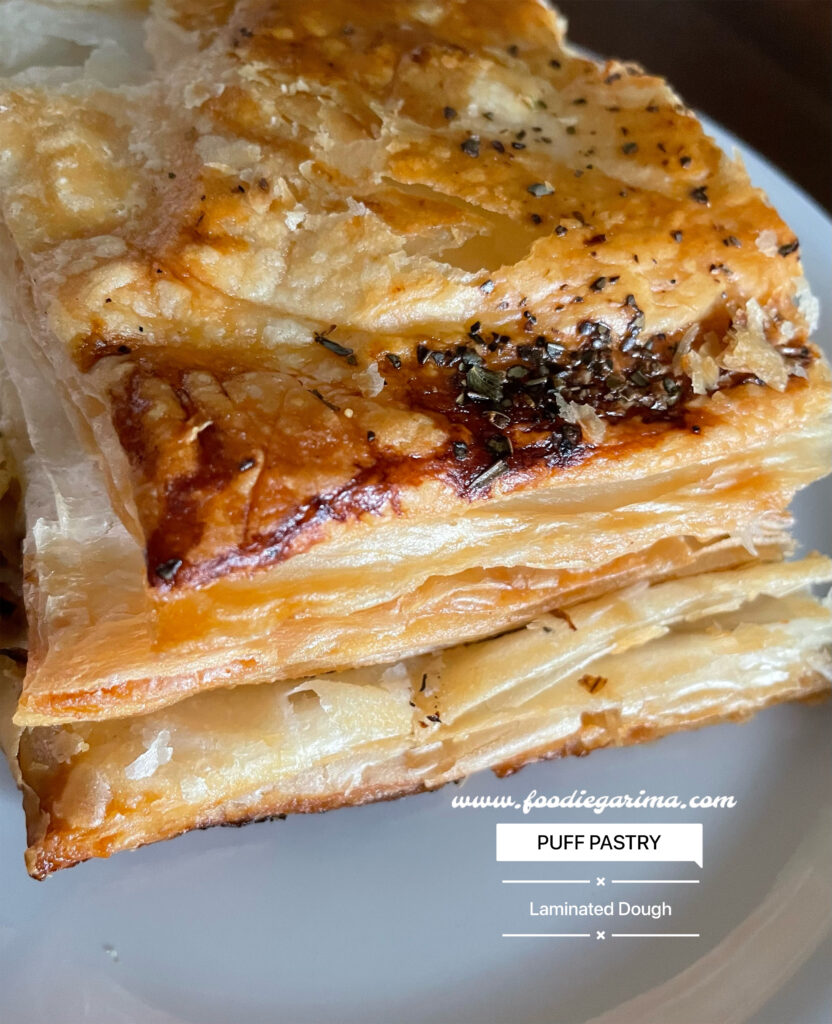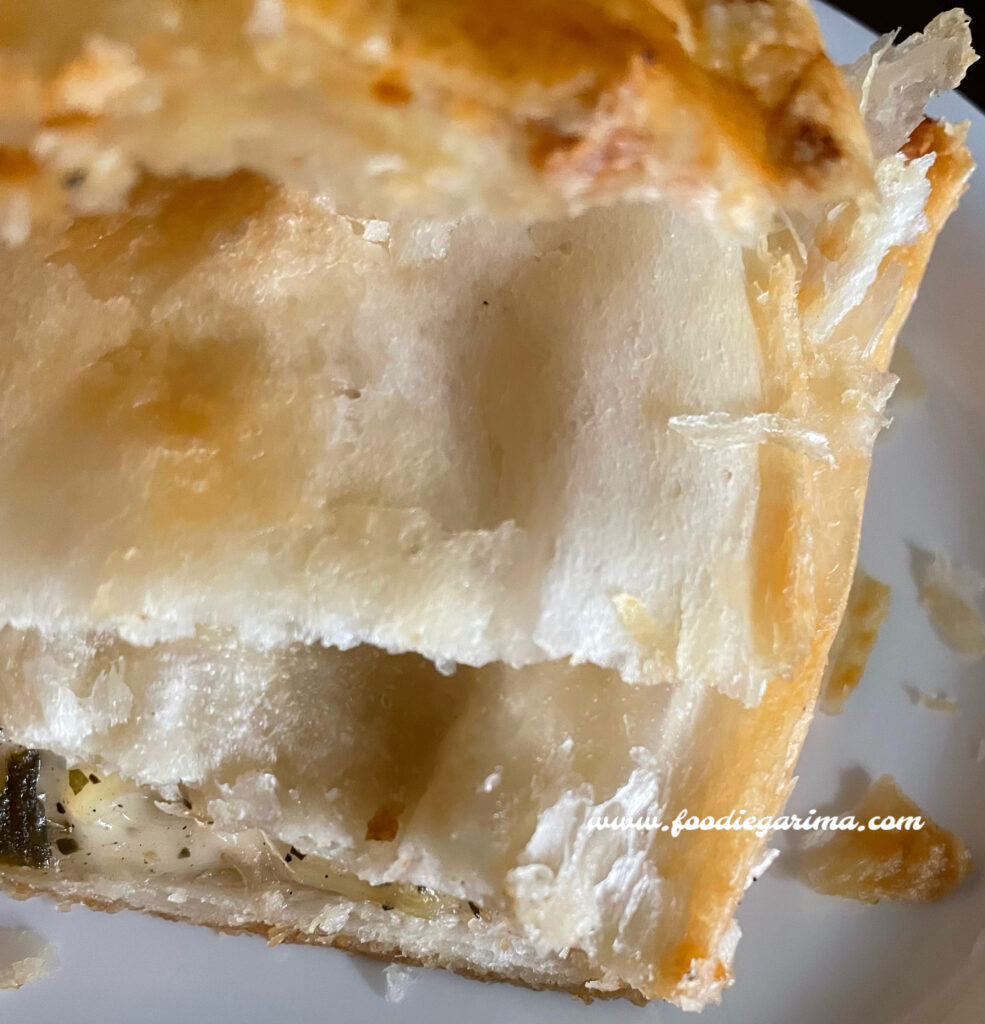23 March, 2023
PUFF PASTRY | Laminated Dough

Puff Pastries – Classical French Pastry
Puff Pastry (Pâte Feuilletėe) is a Super Flaky and Buttery Pastry made with “Laminated Dough”.
What Is “Laminated Dough” ?
“Laminated Dough” is a technique of creating multiple, alternate layers of Dough and Fat (Butter) by rolling and folding it several times.
“Laminated Dough” has several layers of Butter overlapping the Dough. This is what allows it to expand in the oven and gives an end product with several beautiful layers.
Puff Pastry, Croissant and Danish all these are made with “Laminated Dough” which means there is going to be alternate layerings of Butter and Dough in these French Pastries. Laminated Dough is a base recipe we need to make some Pastries.
The Rise In Puff:
Puff Pastry has a little rise and this little rise on Puff is not because of the Yeast as Puff has no Yeast. The layers of the Puff rise because of the alternate layers of Butter.
Puff Pastry has alternate layers of Dough and Butter and Butter has moisture content. So when we bake the puff pastry, this moisture content in the butter starts evaporating or starts releasing between the layers of dough. As a result, the layers get a rise as the butter melts and a gap is formed between the layers of dough.
Steam helps the layers to puff up or get a rise by separating the layers, making it flaky and crispy.
Puff Dough is a base for both “Sweet” & “Savory” products.

Ingredients Of Puff Pastry:
The Ingredients we need for Puff Pastry are : Ice Cold Water, Fat (Frozen Butter), Salt and All Purpose Flour.
All these ingredients should be Super Cold and that’s the secret to make a Puff Pastry super flaky and super amazing.
Cold Butter: Cold Butter makes the layers crispy and flaky. Use the grated butter to make the laminating process quicker.
Cold Water: Cold Water keeps the Butter whole rather than being absorbed. It keeps the dough temperature down and prevents the butter from melting when combined.
Add a little bit of Vinegar or Lemon Juice. Adding Cream of Tartar or Vinegar makes the dough more extensible and elastic by giving strength to the Gluten.
The Making of Puff:
The Puff Pastry making consists of two parts:
Part (1). The Beurrage (Butter), Part (2). The Detrempe (Dough)
Part (1). The Beurrage (Butter Slab):
Ingredients: 3 cups of Unsalted Dry Butter, 1 cup All Purpose Flour.
Dry Butter is important. So add a small amount of Flour to the Butter. Flour absorbs the moisture and makes the butter dry and flexible to work with while Laminating.
Mix these ingredients well in the food processor. Chill it for a couple of hours.
Incorporate this Butter Slab into the dough through a process of Rolling and Folding.
Part (2). The Detrempe (Puff Pastry Dough):
Dough acts as the body of puff pastry.
Quantity: 4 cups All Purpose Flour, 1 cup Ice Cold Water.
Puff Pastry Dough is a “Lean Dough” with not many enriching components like Egg, Milk, Fat and Sugar. Puff Pastry Dough doesn’t have all these things. This is just a dough, a dough with flour and cold water only. This Lean Dough is used for crispiness.
Kneading: Knead or make a dough by mixing these ingredients using a food processor until the dough comes together but is still cool.
Don’t overwork the dough. Don’t knead it for too long as we don’t want to encourage too much Gluten development. Gluten shouldn’t be fully developed.
Overworking the dough can affect the moisture and also tighten the dough.
Let the dough rest and chill in the fridge after kneading. This is important to rest the dough.
Resting the dough helps in relaxing the Gluten strands and starches in the flour to absorb liquid and make it ready for Lamination.
Why Flattening The Dough Before Chilling Is Important?
Flattening helps the dough to chill faster. If the dough is thicker or dense, then the inner part will not chill properly.
Lamination Process:
- Roll the dough into a rectangle about a quarter inch. If the dough is hard to roll out then wrap it in plastic and rest in the fridge for about 15 minutes
- Add butter in between the sheets of dough.
- Wrap the dough around the fat.
- Then roll out and fold over on itself several times to create the layers of fat and dough. Let the dough rest after every roll and fold.
- More than one fold ends up in shrinkage and tearing of dough. When we roll the dough, it stretches and then tries to shrink after rolling. So it is necessary to chill the dough to avoid shrinkage after every fold.
Puff Dough is not sticky as it has layers of fat (butter).

Enclosing The Fat:
Before enclosing the fat, the texture (firmness) and temperature of both the dough and fat needs to be similar.
- If the Dough is too Soft and Butter is too Cold then there are chances for the Dough to tear and Fat might not spread evenly between the layers.
- If the Dough is too Cold and Butter is too Soft then Butter can ooze out of the layers.
Difference Between Puff Pastry And Croissant:
The difference between Puff Pastry and Croissant is because of the Yeast and Butter in the Dough.
Puff pastry is a little bit hard but Croissant is not that much hard. Croissant is a little bit softer because Croissant Dough has butter but Puff Dough doesn’t have butter.
Puff has alternate layers of Dough and Butter but there is not any butter in its dough. Puff Dough is a Lean Dough without Butter and Yeast in it.
Note:
- Margarine or Vegetable Fat can also be used in place of Butter. It has a higher Melting Point than Butter and is also easy to work with. It doesn’t have much moisture content and won’t melt easily. But Margarine can’t give a good texture and flavor. It gives a greasy feel to our palate. People use this only for cost cutting. Which one is better? The flavor and color of the Butter is mostly appreciated by all and it has better quality.
- Top professional chefs use a Dough Sheeter for Lamination.